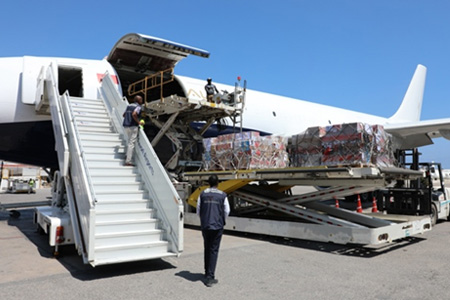
High traffic at points of entry – airports, seaports and land crossings – can play a crucial part in the international spread of disease via people, transport vehicles and goods.
Our points of entry programme focuses on the establishment and maintenance of robust core capacities at various entry points. This is one of the main commitments in the International Health Regulations (2005). This instrument outlines responsibilities and recommendations to enable countries to prevent, prepare for and respond to such public health risks at points of entry.
Points of entry act as key channels for international travel, transport and trade, and serve as a frontline defence against public health threats. Given their vital role, it is crucial that these sites have sufficient capacities and resources both for routine operations and to meet the demands of public health emergencies.
All-hazards approach
As such emergencies range from natural disasters, chemical spills and acts of terrorism to infectious disease outbreaks, an all-hazards approach is needed. This sets in place complete and adaptable preparation and response strategies to manage any public health emergency effectively, whatever its nature.
With the essential resources and capacities in place, countries can effectively respond to public health emergencies and set up a solid coordination mechanism for cross-border collaboration. This strengthens regional and global health security.
WHO provides guidance, assesses travel recommendations, and coordinates simulation exercises, external evaluations and after action reviews. To strengthen the expertise of public health professionals at points of entry, WHO has also developed a range of courses and training materials.
This work is essential to the global circulation of people, goods and services. Globally, the International Air Transport Association expects overall traveller numbers to reach 4 billion in 2024 (1). Tourism has greatly expanded across the WHO Eastern Mediterranean Region, with 128 million arrivals to the Middle East and North Africa in 2019, which generated expenditures of US$ 144 billion – up from 90 million arrivals and US$ 72.5 billion in 2009 (2).
Trade has also grown across the Middle East and North Africa, generating imports valued at about US$ 895 million and exports worth more than US$ 1 billion in 2021 (3). Expanded trade also increased interactions between humans and animals, enabling the transmission of zoonotic disease pathogens.
For these reasons, it is critical to maintain effective health measures at points of entry.
- Air passenger numbers to recover in 2024. Geneva: International Air Transport Association; 2022.
- International tourism, expenditures (% of total imports). World Bank; 2024 (https://data.worldbank.org/indicator/ST.INT.XPND.MP.ZS?most_recent_value_desc=true, accessed 4 March 2024).
- Middle East and North Africa trade. World Integrated Trade Solution; 2021.
Publications
Multimedia
News
Related resources
Minimizing health risks at airports, ports and ground crossings














